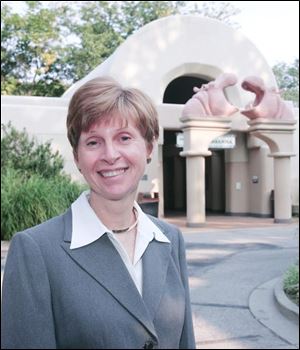
'Extreme Makeover' coming to zoo's frogs
9/11/2007
Baker
The Toledo Zoo will bound into its Year of the Frog with the creation of a half-million-dollar amphibian pad next year, the zoo board learned yesterday.
The amphibian annum is the creation of the Association of Zoos and Aquariums - which accredits member zoos nationwide, including Toledo - to draw attention to the rapid depletion of frogs and salamanders around the planet.
A fungal infection is eliminating frog populations around the world, while habitat destruction erodes important frog and salamander breeding ponds. Pesticides also play a role in the plague frogs face, and global warming appears to be a contributor. Not much is known about the fate of a third type of amphibian known as a caecilian.
The new Toledo Zoo exhibit consolidates the zoo's amphibian displays while making room for more frogs in the museum building, in an area now occupied by the reptiles in the Dragon exhibit, said Anne Baker, the zoo's executive director.
The need for new amphibian space stems from plans for the creation of a $7.5 million children's area, which will use the current frog display area, as well as the outdoor space between the museum, the reptile house, and the Carnivore Cafe. Plans for the Children's Zone were announced last week.
Today, most of the zoo's amphibians are in the 800-square-foot Frog Town. Those frogs, native to northwest Ohio, will move to the new area, as will amphibians now housed in the Reptile House, Ms. Baker said.
"Not only are we going to move Frog Town, we're going to make it bigger," she said.
The biggest change in the remodeled 2,000-square-foot space will be the creation of four "biosecure" displays for endangered species, said R. Andrew Odum, herpetology curator.
The zoo's population of Kihansi spray toads will occupy at least two biosecure displays, Mr. Odum said. The Toledo Zoo played a pivotal role in saving these Tanzanian frogs by developing a successful breeding program. Plans are under way to move some back to their native Tanzania for captive breeding there. The frogs captive-bred in Tanzania will be used to re-establish wild populations there.
Wyoming toads, another endangered species Toledo has worked to save, will occupy the third biosecure display. Mr. Odum said the fourth display's occupant hasn't been determined.
He hopes to see the project completed by April, when the Toledo Zoo will host its fourth AZA-sponsored amphibian-husbandry training program. This program, which spent its first two years at the Detroit Zoo, has trained nearly 100 people so far. Though most of the participants are from U.S. zoos, representatives from others worldwide also attend the husbandry program.
Making that deadline may prove a difficult job.
"It's very complicated to build, actually," Mr. Odum said. "Amphibians are sort of fish with legs, so there are lots of water quality issues" amid the other complications.
In any event, the opening will come too late for the official kick off of the Year of the Frog. That takes place, of course, on Leap Day, Feb. 29, 2008.
Contact Jenni Laidman at:
jenni@theblade.com
or 419-724-6507.